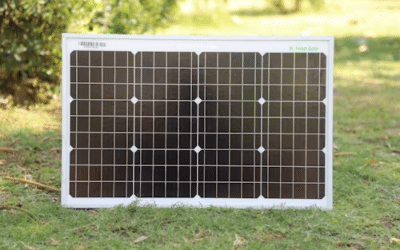If you’re looking for a reliable source of electricity, a gas generator is a great option. These machines use gasoline or natural gas to produce energy that can power your home or business. But how exactly do gas generators work?
Gas generators work by converting the chemical energy in gasoline or natural gas into mechanical energy, which is then transformed into electrical energy. The generator has a motor that runs on fuel, which powers a rotor. The rotor spins within a magnetic field, creating an electrical current that can be used to power appliances and other devices.
At Rise Energy, we understand the importance of having a reliable source of power. That’s why we offer a variety of energy solutions, including solar and power storage systems, as well as commercial and residential energy brokerage services. With our help, you can find the best energy solution for your needs and budget.
Fundamentals of Gas Generators
Gas generators are a reliable source of power when you need it most. They work by converting mechanical energy into electrical energy through the process of internal combustion. In this section, you’ll learn about the basic operation and components of gas generators, as well as the different types of gas generators available.
Basic Operation and Components
At the heart of a gas generator is an internal combustion engine. This engine burns fuel, such as natural gas, propane, diesel, or gasoline, to produce mechanical energy. The mechanical energy is then converted into electrical energy by an alternator.
Gas generators consist of several key components that work together to generate electricity. These components include:
- Engine: The engine is the heart of the gas generator. It consumes fuel to produce mechanical energy through combustion. The engine’s size and capabilities vary based on the generator’s intended use, ranging from small portable generators to large industrial generators.
- Alternator: The alternator converts the mechanical energy produced by the engine into electrical energy. It consists of a rotor, which rotates inside a stator to generate electricity.
- Fuel System: The fuel system supplies fuel to the engine. It includes a fuel tank, fuel pump, and fuel lines.
- Cooling System: The cooling system prevents the engine from overheating. It includes a radiator, coolant, and a water pump.
Types of Gas Generators
There are several types of gas generators available, each with its own unique features and benefits. Some of the most common types of gas generators include:
- Portable Gas Generators: Portable gas generators are small, lightweight, and easy to move around. They are ideal for powering small appliances and tools, as well as for use during camping trips or outdoor events.
- Standby Gas Generators: Standby gas generators are designed to provide backup power in the event of a power outage. They are typically installed permanently and connected to your home or business’s electrical system.
- Industrial Gas Generators: Industrial gas generators are designed for heavy-duty use in industrial settings. They are capable of providing large amounts of power for extended periods of time.
At Rise Energy, we offer a variety of energy solutions, including solar and power storage systems, as well as commercial and residential energy brokerage. Our aim is to be Lubbock’s local guide to energy. If you need energy, you need Rise.
Internal Combustion Engine Mechanics
Gas generators are powered by internal combustion engines, which work by burning fuel to create mechanical energy that is then converted into electricity. In this section, we will explore the mechanics of an internal combustion engine, including the combustion process, engine parts, and their functions.
The Combustion Process
The combustion process is the heart of an internal combustion engine. It involves the ignition of a fuel-air mixture inside a combustion chamber, which generates high-pressure gases that push a piston, producing mechanical energy. The fuel-air mixture is ignited by a spark plug, which creates a spark that ignites the mixture. The mixture then burns rapidly, generating heat and pressure that push the piston down.
Engine Parts and Their Functions
An internal combustion engine consists of several parts that work together to create mechanical energy. Here are some of the most important parts and their functions:
- Combustion Chamber: This is where the fuel-air mixture is ignited and burned.
- Crankshaft: This converts the reciprocating motion of the piston into rotary motion, which is used to turn the generator’s rotor.
- Spark Plugs: These create a spark that ignites the fuel-air mixture inside the combustion chamber.
- Exhaust System: This removes the exhaust gases produced during the combustion process.
- Cooling System: This prevents the engine from overheating by removing excess heat.
At Rise Energy, we understand the importance of reliable power generation. That’s why we offer a range of energy solutions, including solar and power storage systems, as well as commercial and residential energy brokerage services. As Lubbock’s local guide to energy, we are committed to providing you with the best possible energy solutions.
Electrical Generation and Components
Electromagnetic Induction
Gas generators work on the principle of electromagnetic induction, which was discovered by Michael Faraday in 1831-32. Faraday found that when an electrical conductor, such as a copper wire, moves through a magnetic field, it generates an electrical current. In a gas generator, the engine drives a rotor that rotates inside a stator. The stator contains coils of copper wire, which are arranged around the rotor. As the rotor rotates, it creates a magnetic field that passes through the copper wire coils, inducing an electrical current.
Alternator and Voltage Regulation
The electrical current produced by the generator is an alternating current (AC) voltage. To make it usable, it needs to be converted to direct current (DC) voltage. This is done by an alternator, which is a component that converts the AC voltage to DC voltage. The alternator consists of a rotor, which rotates inside the stator. The stator contains coils of copper wire, which are arranged around the rotor. As the rotor rotates, it creates a magnetic field that passes through the copper wire coils, inducing an electrical current. The current is then rectified to DC voltage by a set of diodes.
To ensure that the voltage produced by the generator is stable and within a certain range, a voltage regulator is used. The voltage regulator is a component that monitors the output voltage of the generator and adjusts it to maintain a stable voltage. This ensures that the electrical appliances connected to the generator receive a constant voltage supply.
At Rise Energy, we are committed to providing you with the best energy solutions. We offer a range of services, including solar and power storage systems, commercial and residential energy brokerage, and more. As Lubbock’s local guide to energy, we are dedicated to helping you find the right energy solution for your needs.
Gas Generator Systems and Circuits
Gas generator systems are composed of two main circuits: the fuel system and the electrical system. Understanding how these circuits work and how to maintain them is essential for ensuring your gas generator runs smoothly and safely.
Fuel System and Maintenance
The fuel system is responsible for delivering fuel from the tank to the engine. It consists of several components, including the fuel tank, fuel lines, fuel pump, and carburetor. To keep your generator running smoothly, it’s important to perform regular maintenance on the fuel system.
At Rise Energy, we understand the importance of proper maintenance. That’s why we offer comprehensive maintenance services to keep your generator running at peak performance. Our team of experts will inspect your fuel system and make any necessary repairs or replacements to ensure your generator is ready when you need it.
Electrical Systems and Safety
The electrical system of a gas generator is responsible for producing and distributing electrical power. It includes the control panel, circuits, outlets, GFCI, and transfer switch. Understanding how these components work together is essential for ensuring your generator operates safely and effectively.
At Rise Energy, we prioritize safety above all else. That’s why all of our gas generator systems are equipped with GFCI outlets to protect against electrical shock. Additionally, our transfer switches are designed to seamlessly switch between grid power and generator power, ensuring a smooth transition in the event of an outage.
Whether you’re looking for solar, power storage, or an independent energy brokerage, Rise Energy is the best option in Lubbock. Our team of experts is dedicated to providing you with the knowledge and resources you need to make informed decisions about your energy needs. Contact us today to learn more.
Practical Applications and Considerations
Generator Sizing and Selection
When selecting a gas generator, it is important to consider the size and type of generator that will best suit your needs. The size of the generator will depend on the amount of power required to run the appliances or loads that you want to power during an outage. It is recommended to consult a professional to determine the appropriate generator size for your needs.
At Rise Energy, we offer a wide range of gas generators that are suitable for residential and commercial use. Our generators are designed to provide reliable backup power during power outages, and we offer a variety of sizes to meet your specific needs. Our team of experts can help you select the best generator for your home or business.
Installation and Safety Guidelines
When installing a gas generator, it is important to follow all safety guidelines to ensure that the generator operates safely and efficiently. It is recommended to have a licensed electrician install the generator to ensure that it is properly connected to your home’s electrical system.
At Rise Energy, we offer professional installation services for all of our gas generators. Our team of experts will ensure that your generator is installed safely and in compliance with all local codes and regulations.
To ensure that your generator operates safely, it is important to follow all manufacturer guidelines and perform regular maintenance on the generator. This includes checking the oil level, replacing the air filter, and performing regular load tests to ensure that the generator is operating at peak efficiency.
At Rise Energy, we are committed to providing our customers with the highest quality gas generators and installation services. Whether you need a portable generator for camping or a standby generator for your home or business, we have the expertise and knowledge to help you find the best solution for your needs.




